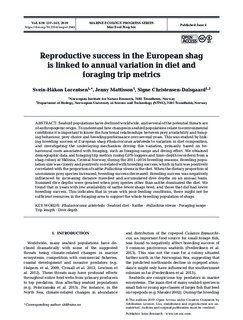Reproductive success in the European shag is linked to annual variation in diet and foraging trip metrics
Journal article

Åpne
Permanent lenke
http://hdl.handle.net/11250/2600633Utgivelsesdato
2019Metadata
Vis full innførselSamlinger
- Scientific publications [1392]
Originalversjon
10.3354/meps12949Sammendrag
Seabird populations have declined worldwide, and several of the potential threats are of anthropogenic origin. To understand how changes in seabird populations relate to environmental conditions it is important to know the functional relationships between prey availability and foraging behaviour, prey choice and breeding performance over several years. This was studied by linking breeding success of European shag Phalacrocorax aristotelis to variation in diet composition, and investigating the underlaying mechanism driving this variation, primarily based on be - havioural costs associated with foraging, such as foraging range and diving effort. We obtained demographic data and foraging trip metrics (using GPS-loggers and time−depth recorders) from a shag colony at Sklinna, Central Norway, during the 2011−2016 breeding seasons. Breeding population size was closely and positively correlated with breeding success, which in turn was positively correlated with the proportion of saithe Pollachius virens in the diet. When the dietary proportion of uncommon prey species increased, breeding success decreased. Breeding success was negatively influenced by increasing distance travelled and accumulated dive depths on an annual basis. Summed dive depths were greatest when prey species other than saithe dominated the diet. We found that in years with low availability of saithe fewer shags bred, and those that did had lower breeding success. This indicates that in years with poor feeding conditions, there might not be sufficient resources in the foraging area to support the whole breeding population of shags.
